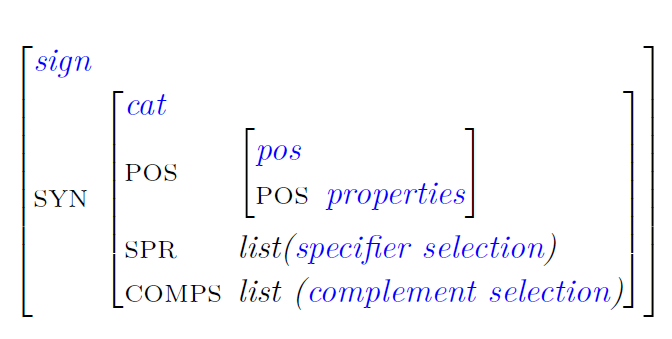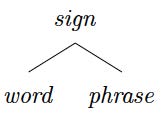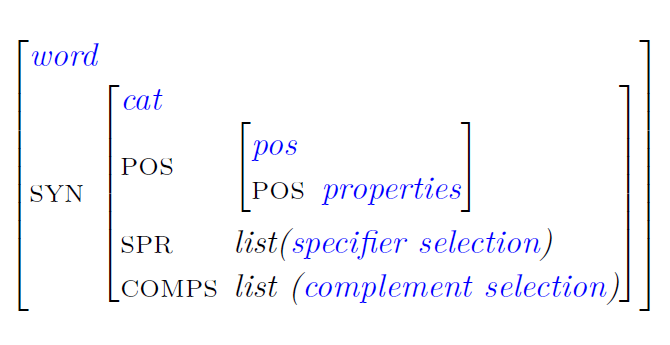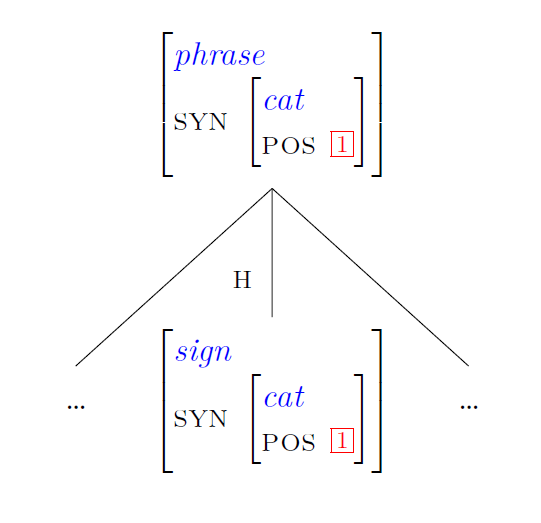Syntax 1 Wiki: Week 5
Introduction
In the first weeks of this course, we have dealt with the topics:
a. Parts of speech and their features
b. Predicate-argument Structure
This week, we are going to bring these topics together. Remember what the purpose of feature structures like the one below is:
Feature structures describe an object (represented by the feature structure type in the top-left) by describing the values of the features that are relevant for that object. Thus, for a book we find such features as TITLE and AUTHOR, but not PHONE-NUMBER. The entries in a book catalogue will then presumably all be different, since they describe different books with different properties (= values for features), but the entries are all going to be structured similarly, since each entry describes a book with a feature structure of type book.
Consider now the problem we face when we want to represent what speakers know about the words of their language. For simplicity's sake, we can assume that the speakers have something like a dictionary book in their heads, i.e. a long list of word entries. As in the book example above, the entry for each word will be different from the entries of all other words, but of course words have some features in common that we can capture in a feature structure type word. For instance, every word will have a SYNTACTIC (SYN) feature whose value specifies the syntactic properties of the word. We are now beginning to define feature structure types for linguistic objects. Of course, as with every feature structure we will make sure that the features we postulate for a particular kind of linguistic object reflect the properties of that object!
Before we define the feature structure type word, it is economical to first define the feature structure type sign. The reason is that all words are signs and therefore words have all the properties of signs. Besides words (N, V, etc.), there is only one other specific type of sign, namely the syntactic phrase (NP, VP, etc.). So, our strategy will be the following:
- We define the most general feature structure type.
- When there are objects that are specific versions of the general type, we define types for them, declare the more specific types as subtypes of the more general type.
- In the definitions of the subtypes we only specify those features and values that those types have in addition to their super type.
Feature structures of type sign
So, in accordance with this procedure, we will define the type sign first. In preparation for this, we will look at a feature structure of type sign:
Note that this feature structure is of the general format we specified for all feature structures:
- In the top left we find the feature structure type: sign.
- Below the type, we find two rows of the form [FEATURE value]:
- the feature SYN whose value is a feature structure of type cat (category). The attributes of the feature structure of type cat are POS (part of speech), SPR (specifier), and COMPS (complements). The POS attribute(feature) has a corresponding value, which is a feature structure of type pos. The feature structure of type pos takes also features and values (i.e. the number and type of features depends on the category of the word we are describing). For example, if we are describing a word of category v(verb), the features(attributes) will be VFORM (verb form) and AUX(auxiliary). The value of the VFORM feature could be a finite or a non-finite (base, presp, perfp) forms. The value of the AUX feature can be either plus + or minus -. The + symbol would mean that the verb we are describing is a modal verb and the minus -- that the verb is not modal. The SPR attribute has a value, which is a list of possible specifiers and the COMPS attribute has a value, which is a list of possible complements.
Since lists and complexes of syntactic properties have internal structure (i.e. consist of parts), we describe these objects again in terms of feature structure types that are appropriate for a description of these objects.
It is easy to feel overwhelmed by the representation above at first, but don't worry! You will see so many concrete examples of this general structure, that very soon you can draw it in your sleep!
Above, we said that sign has two subtypes, word and phrase. We will graphically represent that state of affairs as follows. A type that is connected by a line to another type above it is said to be a subtype of the type above. From the point of view of the higher type we say that it is a supertype of the first type.
Let us, then, define the two subtypes.
Feature Structures of Type word
The definition of the type word is short. It is simply: word.
This may look funny, because it seems that according to that definition words have no grammatical properties. But remember that an object of type t has all the properties of all supertypes of t. If t does not add any features or more specific values of the features to the information in its supertypes, then any object of type t still has all the properties of all the supertypes of t plus the information that it is an object of type t.
Applying this logic to the type word, all words will have feature structures like the following:
Note again that this feature structure differs in only one respect from the feature structure for sign which we gave above: the new feature structure is of type word. This is the only information contributed by the type word in addition to the fact that word is a subtype of sign. Because of this subtype relationship, the feature structure of type word inherits almost all its information from the feature structure of type sign.
Feature Structures of Type phrase
The type phrase:
Unlike the type word, the type phrase adds two FEATURE-value pairs to the information that it inherits from the type sign. The first feature is DTRS (= DAUGHTERS) of type list, which means that phrases may have daughters. For instance, sentences typically have the daughters NP and VP. One of these daughters is more important than all the others and this daughter is called the head daughter. This daughter is described by the feature HEAD-DTR, whose value is of type sign.
The Head-Feature Principle (HFP)
Phrases and their head daughters have identical parts of speech (POS) features.
Feature Structures of Type phrase with Inheritance
Feature structures of type phrase will therefore have the information in the previous representation plus all the information in feature structures of type sign. The reason is of course that phrase is a subtype of sign. All feature structures of type phrase must contain all of the following information:
If you now compare the filled-in feature structures of types word and phrase with each other, you find the following similarities and differences:
Both have the SYN feature. phrase in addition has the features DTRS and HEAD-DTR which word lacks.
Our system of types and subtypes thus encodes that words and phrases have syntactic, information, but that phrases have internal phrase structure which words lack. This difference reflects the fact that words are the smallest unit of syntax and cannot be broken down into smaller syntactic units, whereas phrases must contain at least one other syntactic unit.
Navigation:






